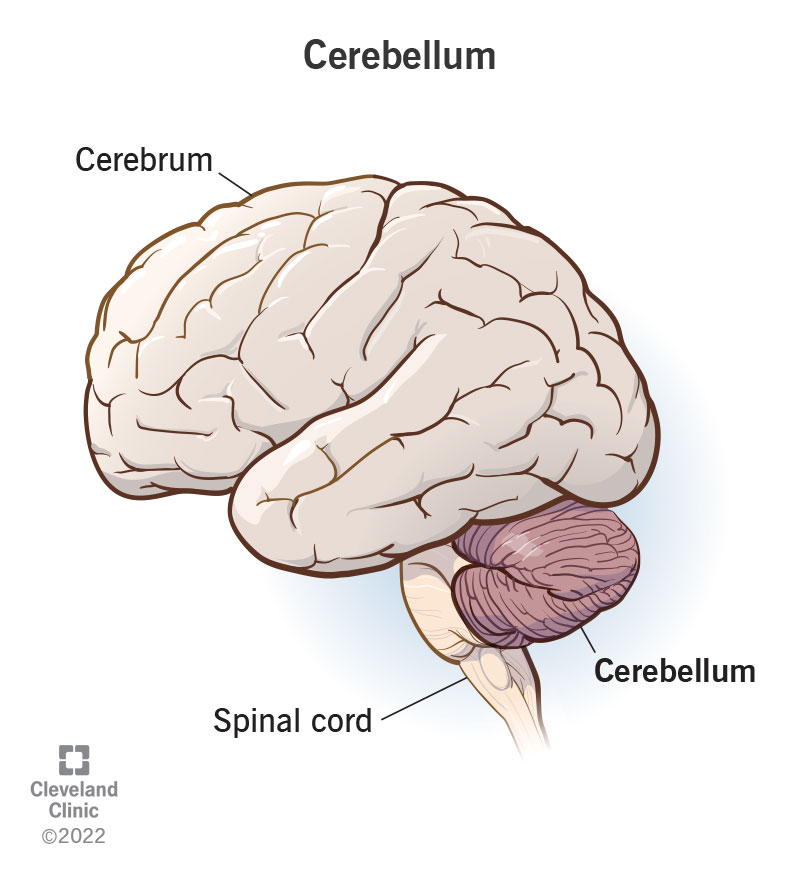Your cerebellum is part of your brain that helps coordinate and regulate a wide range of functions and processes in both your brain and body. While it’s very small compared to your brain overall, it holds more than half of the neurons (cells that make up your nervous system) in your whole body.
Advertisement
Cleveland Clinic is a non-profit academic medical center. Advertising on our site helps support our mission. We do not endorse non-Cleveland Clinic products or services. Policy

Your cerebellum is a part of your brain located at the back of your head, just above and behind where your spinal cord connects to your brain itself. The name “cerebellum” comes from Latin and means “little brain.”
Advertisement
Cleveland Clinic is a non-profit academic medical center. Advertising on our site helps support our mission. We do not endorse non-Cleveland Clinic products or services. Policy
For centuries, scientists believed your cerebellum’s job was to coordinate your muscle movements. Advances in technology have shown that your cerebellum does much more than that. There’s much that scientists are still trying to understand about the cerebellum, including all the ways it works with the rest of your nervous system.
Your cerebellum is a small part of your brain located at the bottom of this organ near the back of your head. Your cerebrum is the largest part of your brain and includes parts above and forward of the cerebellum.
Scientists started analyzing the cerebellum more than 200 years ago by studying people or animals with cerebellum damage. They found people with this kind of damage usually had trouble keeping their balance while standing or walking, or they’d have trouble reaching for objects because their hands would miss an object they were trying to pick up.
Over time, scientists started finding evidence that cerebellum damage could have other effects. They found that damage could make it harder or for a person to learn new words or skills. Damage to your cerebellum can interfere with judging the size of or distance from objects. It can also affect your sense of timing. As an example, people with damage to their cerebellum may have trouble repeatedly tapping their fingers, causing them to tap too soon or too late from beat-to-beat.
Advertisement
Advances in technology have done even more to improve experts’ understanding of the cerebellum. Now, scientists can image a person’s brain activity while that person does a certain task. What scientists have found (so far) is that different parts of your cerebellum are more active depending on what you’re doing at the time. They’ve also found that your cerebellum plays a role in emotions and how you make decisions.
There are cases of people born with cerebellar agenesis, which is being born without a cerebellum. This condition is extremely rare. Many people with it have only minor effects. They can walk and have lives that are more or less like anyone else’s. Others have severe symptoms and will need constant medical care for their entire life.
People can also survive injuries or diseases that damage their cerebellum, but it’s common for them to have long-term or permanent issues.
Neurons are specialized cells that make up your nervous system, including your brain, spinal cord and all of your nerves. Your cerebellum is only about 10% of your brain in terms of how much space it takes up. However, it holds about half of all the neurons in your entire body.
Your cerebellum is also incredibly compact. The brain tissue that makes up your cerebellum is a sheet folded up like an accordion. Laid flat, it would be a little over 3 feet long and 4 inches wide (1 meter by 10 centimeters).
Your cerebellum is inside of your head, at about the same level as your ears. In relation to the rest of your brain, it’s at the very bottom and sits just above where your neck meets your skull.
Your cerebellum forms a half-circle shape around your brain stem, which connects your brain to your spinal cord. It has a series of horizontal grooves from top to bottom.
Your cerebellum is a pinkish-gray color.
The average adult cerebellum is about 4.5 inches (11.5 centimeters) wide. In the middle, it’s between 1 inch and 1.5 inches (3 centimeters - 4 centimeters) tall. On the sides, it’s between 2 inches and 2.5 inches (5 centimeters - 6 centimeters) tall.
The average adult cerebellum weighs between 4.8 ounces and 6 ounces (136 grams - 169 grams).
Any condition that can affect your brain can affect your cerebellum. Some major examples include:
Advertisement
Many symptoms can happen with conditions affecting your cerebellum. Some of the most common symptoms include:
Many types of tests can help diagnose conditions that affect your cerebellum, including:
The treatments for conditions that affect your cerebellum depend entirely on the conditions themselves. They can range from antibiotics for bacterial infections to radiation and chemotherapy for brain tumors. There’s no one-size-fits-all for treating problems that affect your cerebellum.
Advertisement
You can do several things to help prevent damage to your cerebellum or avoid conditions that affect it.
Your cerebellum is a critical part of your brain, and as scientific understanding of it grows, it becomes clearer just how important your cerebellum is. Improvements in medical technology and understanding mean that healthcare providers can better diagnose and treat many of the conditions that affect it. However, it will take much more scientific research to fully unlock the secrets of this small — yet powerful — part of your brain.
Advertisement
If you have a neurological condition, you want expert advice. At Cleveland Clinic, we’ll work to create a treatment plan that’s right for you.

Last reviewed on 07/07/2022.
Learn more about the Health Library and our editorial process.